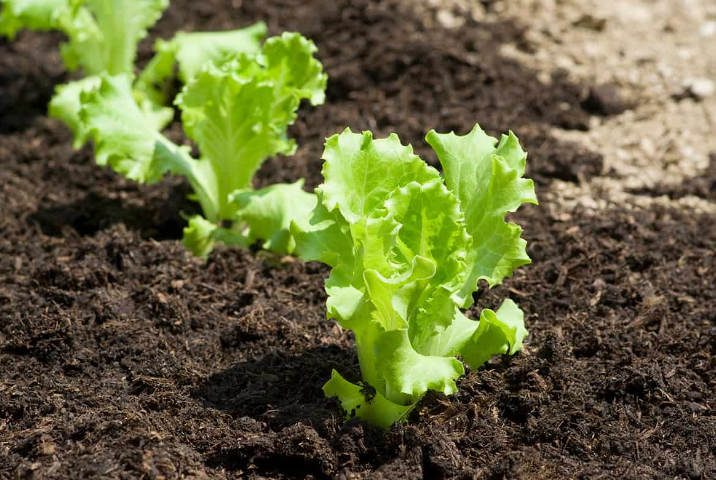Will Lettuce Grow Back Once Cut? 3 Ways to Harvest Lettuce

Lettuce is one of the most versatile vegetables on our daily menus; guessing a meal without a salad is difficult. So, how can we ensure we get a continuous supply of these lovely leafy greens? Does lettuce regenerate after harvest, and if so, how long does it keep cropping?
Will lettuce grow back once cut? Here we will explain how to sustainably harvest lettuce for long periods of time with only a few strategic sowings.
Lettuce regrows once its leaves have been cut or picked off the main stem. As long as the root is intact in the ground and there are at least 1-2 inches of stem and leaves at the base, lettuce will shoot new growth in as little as a week. The cut-and-come-again harvesting method is the most popular.
will lettuce grow back once cut? You can even regrow lettuce indoors, from kitchen scraps – it’s that easy, and it’s basically free food. Simply place the lettuce stem in a shallow water dish, give it access to light and replace the water daily. You should start seeing mature leaves that you can harvest in about 14 days.
Harvesting Lettuce for Maximum Regrowth
There are three main ways of harvesting lettuce, all of which can be used as a continuous source of fresh leaves:
1. The cut-and-come-again method – perfect for leaf lettuce
The cut-and-come-again method is straightforward, and, as the name suggests, you can come again to find new growth in no time. Using scissors, snip leaves at the base, making sure to leave about two inches of stem below. These will serve as the base from which all new growth will emerge.
- Tip: You can use any scissors on hand, or even a knife for the cut-and-come-again method, but I find that dirt and water quickly damage the blades. I love using Teflon trimming scissors to avoid corrosion. It’s also great for delicate pruning (like those pesky tomato suckers) and harvesting all kinds of herbs and leaves.
The cut-and-come-again method works best on certain lettuce varieties – particularly looseleaf lettuce and romaine – but you can even cut head lettuce varieties and expect to see new growth.
I like to use the cut-and-come-again method on rows of looseleaf lettuce. I sow my lettuce seeds directly in the ground, in drills, and don’t do any thinning. As the seedlings grow, they will form a densely packed row of foliage. I harvest from one row for a week and then let it regrow as I move on to the next row.
My favorite varieties for cut-and-come-again harvesting:
- Salad Bowl Green
- Salad Bowl Red
- Black Seeded Simpson
- Lollo Rossa
2. The leaf picking method – perfect for head lettuce
Leaf picking can be a tidy and attractive harvesting method if done right. When picking leaves off lettuce plants, you need to focus on only harvesting the bottom leaves. Pick all the bottom leaves that are mature before moving on to the next plant.
Keep two buckets by your side – one to carry your harvested leaves in, the other to hold damaged leaves. Leaves that are yellow or eaten by insects or slugs can go into the compost bin.
If you pick leaves regularly, the lettuce plants will grow upwards. Their stems will be thick and tall, resembling tiny palm trees – much like kale plants that have been harvested in a similar fashion.
Leaf picking isn’t limited to looseleaf lettuce varieties. You can pick the outer leaves off butterhead lettuce plants, although it’s best to allow them to form heads.
My favorite varieties for leaf-picking:
- Lollo Rossa
- Lollo Bionda
3. Harvesting lettuce heads – one and done
Not all lettuce varieties can be harvested for individual leaves. Some lettuce plants form tight, crisp heads that resemble cabbage, and others mature into luscious, velvety heads called butterhead. These cultivars are best grown until they reach maturity and form whole heads.
Will lettuce grow back once cut? You might find it hard to wait that long, as some head lettuce can take as much as 70 days to become ready for harvest. But if you master succession planting and stagger your head lettuce sowings, as well as combine them with looseleaf lettuce harvests, you’ll have a continuous supply of various lettuce plants.
Lettuce heads have their own advantages – they keep fresh for longer, whether that’s in the fridge or the ground until it’s time for harvest, and their tender core leaves are crisp and delicious.
My favorite head lettuce varieties are:
- Ice Queen
- Great Lakes
- Little Gem

How do you harvest lettuce without killing the plant?
You’ve probably guessed that pulling an entire lettuce plant out of the ground won’t get you too far. So I recommend you stick with methods #1 and #2 for maximum production.
Will lettuce grow back once cut? To avoid killing your plants with the cut-and-come-again method, you want to leave at least 2 inches at the base, if not more, and give the lettuce plants enough time to regenerate before harvest. This method is perfect for ease of picking but it won’t last you as long as the leaf picking method because the lettuce plant will need to go through a strenuous regrowth process .
If you decide to pick the leaves on your lettuce plant (my preferred method), then it’s best to only pick the bottom 2-3 rows, so it has plenty of leaves left to keep growing and staying healthy. Don’t just harvest half the plant and call it a day .
How to succession sow lettuce – growing lettuce all season
You can only get so much growth from one single sowing of lettuce. Once it’s mature, you can harvest leaf lettuce for a month or so before it starts getting bitter and goes to seed. That’s why sowing seeds or starting lettuce seedlings in plug trays several times during the growing season is important for giving you salad greens continuity.
- Tip: I grow one batch of lettuce in a single 72-cell plug tray to last me for months (this is the tray size I’m using). Since lettuce regenerates, there’s no need to go crazy and sow too much.
In our temperate climate, growing lettuce outdoors is possible from mid-March to late September without any additional methods of extending the season. You can harvest lettuce grown outdoors from only four strategic sowings:
- in early to mid-March
- in early June
- in mid-July
- in mid-August
The August sowing is meant to last under protection (cold frames, polytunnel, greenhouse) throughout the winter months, if your winters are mild, or at least until the first frost. If you don’t have a greenhouse or polytunnel, you can extend the season if you cover them with a low plastic tunnel and shelter them with strawbales on either side.
How to help lettuce grow in the summer months
The best time for lettuce to develop is during May. That’s when they taste best and grow fast and vigorous. But when the heat of summer arrives, growing lettuce can prove to be a difficult task as some varieties immediately go to seed or look limp and lifeless.
Start your seeds indoors if you’re growing in module trays because you can control the heat and humidity, and the temperatures aren’t as extreme as outside in the scorching summer months. Direct sow seeds in a shaded part of the garden and keep the ground constantly moist.
Use shade to your advantage and shelter the tender lettuce leaves from the strong sun. You can either interplant lettuce in between tall plants or use a shade cloth to protect them. Either way, know that lettuce doesn’t need much sunlight and thrives in the cooler, partially shaded areas of your garden. Read more about growing lettuce in the shade in this article.
How long does it take for your lettuce plant to grow back?
Cutting the lettuce leaves using the cut-and-come-again method usually brings them back within a week or two, depending on the variety and growing conditions.
I always like having multiple rows of looseleaf lettuce or lettuce tightly sown and packed together. I start at one end of the row and harvest a little bit every day, and by the time I make my way to the second row, the first row of lettuce is already starting to grow back. It’s like an endless supply!
Conclusion
Will lettuce grow back once cut? Lettuce is more than just a spring crop. It’s an all-year-round delightful green that keeps on giving. Use the cut-and-come-again method to provide clean, dirt-free leaves of various sizes, or prune the lettuce plant to get large, mature leaves. Enjoy crisp hearts and layers of delicious leaves when growing lettuce for heads. Happy gardening!
Ciara Konhaus

I’m Ciara and I’m a gardener and agricultural educator in zone 6b. I’ve farmed and gardened all over the Appalachian mountains and love to empower people with the tools they need to start their own gardens.
